Handmade baby quilts are a priceless gift because they allow you to choose colors, themes, or special fabrics that hold a special meaning. Plus, nothing says that you care about a new life as much as the hours you put into making a unique blanket just for that precious little one! If you wonder how big to make your blanket, you may want to refer to this complete guide for baby quilt sizes before you begin.
The most popular sizes for baby quilts include a 30” X 40” newborn or baby quilt and a 30” X30” preemie quilt. As babies grow, a 36” X 56” crib quilt works nicely. Babies and parents together also enjoy a 50” X 65” lap quilt or throw.
In this article, you will find several handy charts to help you plan the sizing of your baby quilt. You will learn about the four most common sizes of baby quilts. Finally, you will find tips for how to make a baby quilt and what kind of material to use.
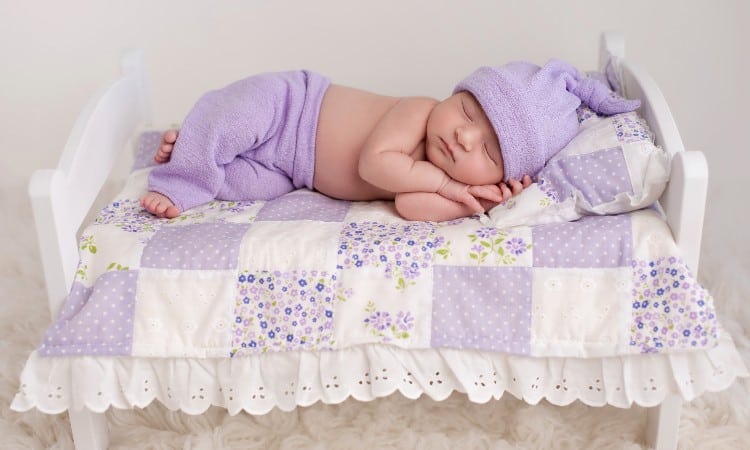
Quick Navigation
Baby Quilt Size Chart
If you need an at-a-glance measurement for your baby quilt, check out this chart that gives you the size of common baby quilts in inches and in centimeters.
Keep in mind that you can find some slight variations in these sizes. This chart offers the standard, most popular measurements, but you can also find patterns with slightly larger or smaller measurements for each quilt style.
| Type of Quilt | Quilt Size in Inches | Quilt Size in Centimeters |
| Newborn or Preemie | 30” X 30” | 76.2 X 76.2 |
| Newborn or Preemie | 30” X 40” | 76.2 X 101.6 |
| Crib or Cot | 36” X 52” | 91.44 X 132.08 |
| Toddler (small) | 36” X 52” | 91.44 X 132.08 |
| Toddler (larger) | 70” X 90” | 177.8 X 228.6 |
| Lap Throw | 46” X 60” | 116. 84 X 152.4 |
Four Standard Baby Quilt Sizes
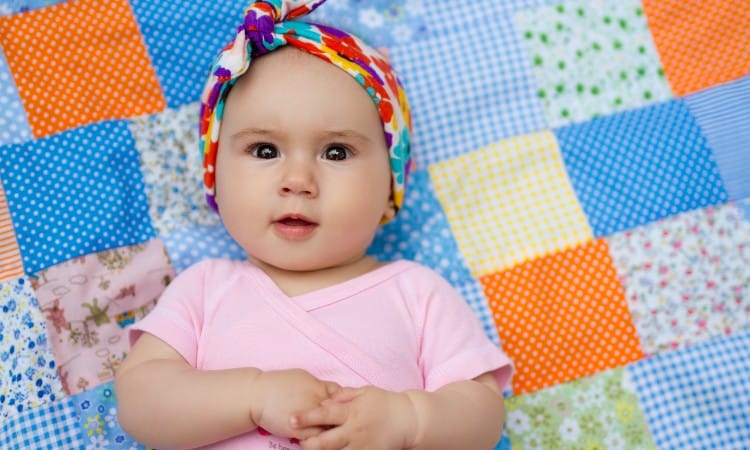
The four most popular standard baby quilt sizes include a preemie quilt size, a crib quilt, a toddler quilt, and a lap quilt size. Of course, you can make a handmade quilt in pretty much any size you want! But choosing a standard size is easier because you can find many resources to help you cut out and plan your quilt in those popular sizes.
One easy way to pick the best quilt size is to choose a size intended for the baby’s age. For instance, newborn quilts usually come in small squares, while toddler quilts come in much larger rectangles.
1. Preemie and Newborn Quilt
The most popular size for a preemie or newborn baby quilt is a 30” square. However, you will see some variations on this. Some organizations recommend quilts as small as 22” square for preemies, while others like the extra room provided in a 30” X 30” blanket.
A 30” square also works great for newborns in general and is a great gift to brand-new parents who may want to use the quilt in the hospital or as a car seat cover on the way home. This size is small, compact, and easy to maneuver while handling all the “baby paraphernalia” like diaper bags and strollers.
One of the great things about this small, square baby quilt is that you can easily use a solid piece of fabric for the quilt’s backing, rather than having to piece together fabric as you would for a larger quilt.
Plus, making a square quilt also simplifies the quilt blocking process!
That said, a 30” X 40” rectangle comes in as a close second for a popular baby quilt size for newborns, too. If you prefer a rectangular quilt, this slightly larger measurement does give you a bigger canvas to work on as you create your unique quilted pattern!
2. Crib or Cot Quilt
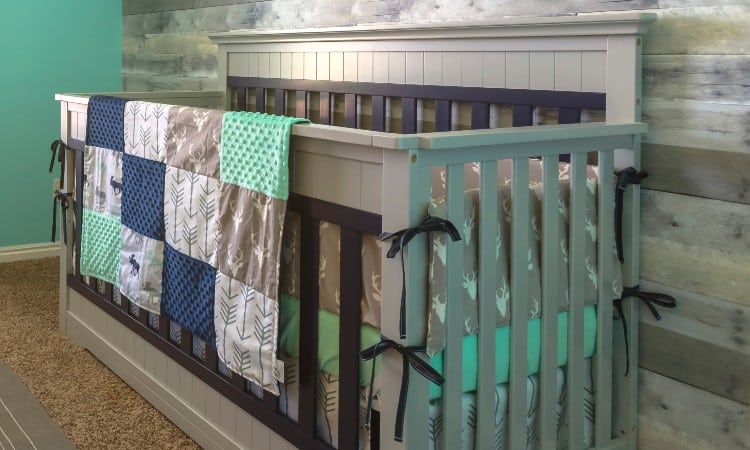
Baby cribs or cots almost always have a standard-sized mattress, which means that a standard size quilt should fit that mattress with 36” X 52” measurements. This sort of quilt, coming in at a much larger size than the average newborn blanket, will likely stay with the baby through much of his or her early childhood!
However, please note that experts do not advise allowing infants to sleep with heavy quilts or blankets. This kind of crib quilt mostly serves a decorative purpose in the crib until the baby is six months old or older.
On the other hand, a baby will quickly outgrow the newborn-sized 30” square quilt, while this nice big crib-sized quilt will remain cozy for years to come! Parents can use this size of a quilt as a floor mat or as a lap throw.
3. Toddler Quilt
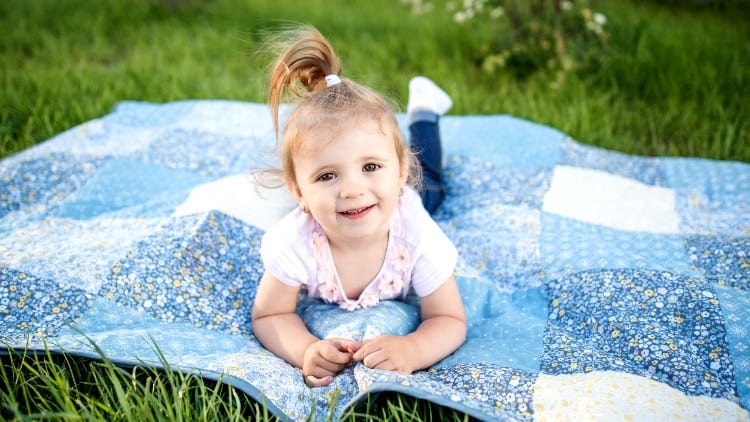
The most popular size for a toddler quilt is 46” X 70”, which will fit the standard-sized toddler mattress. However, you also see many toddler quilts made in either the standard crib quilt size of 36” X 52” or a rectangle as big as 70” X 90”, depending on the size of the toddler’s bed.
Toddlers range in age from two years old to four or five years old. If you want to create a gift that the new little one can enjoy for a very long time, you may want to consider making a toddler quilt.
Of course, you will want to consider that you will need more fabric for this larger blanket. The average toddler blanket will require about 1 ⅔ yard of fabric for the front of the quilt and batting and material for the quilt backing.
4. Lap Quilt
The most popular size for a lap quilt is 46” X 60”, though you will see a lot of variation in sizing for this style of quilt. This is because this quilt does not need to fit over a standard-sized mattress. Instead, parents can use it to snuggle up together with the new baby!
The only real rule with a lap quilt is that you want it to allow enough room to generously cover the adult and child together. The benefit of using one of the more popular sizes, like 46” X 60” is that you can often find free patterns or quilt blocking designs online when you use a more standard measurement.
Other popular sizes for a lap quilt include 36” X 48” and a 36” X 36” square. A 36-inch square baby quilt also makes a popular type of floor mat or playspace!
You can make lap quilts quite simply if you want to quickly stitch up your design, but you also do some very intricate, artistic designs used in lap quilts in particular. These blankets sometimes do not see quite such hard use as a crib quilt or a newborn quilt, so you can more easily invest a lot of time in making them beautiful!
What is the Best Size Square for a Baby Quilt?
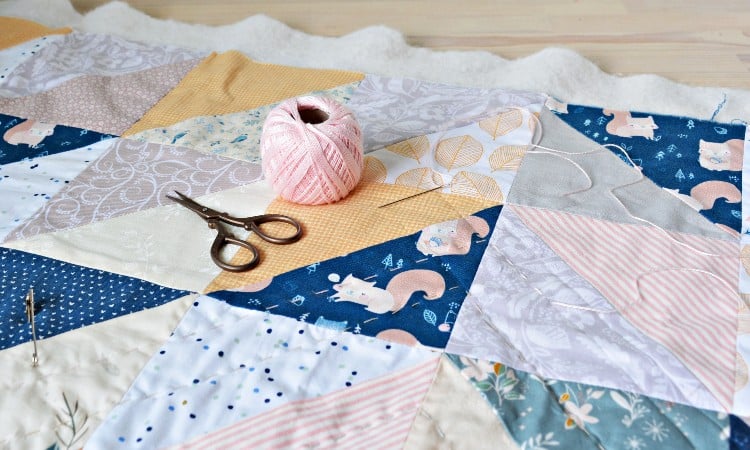
The best size square for a baby quilt is usually four or five inches, but this does depend on the size of the whole quilt. You want your quilt squares to easily divide into the total area you have selected as the quilt size!
Other popular quilt square sizes include 6” squares and 12” squares. You will also find some popular baby quilt patterns that use 10” squares.
But how do you know how many squares to use in your quilt?
Here is an easy way to figure out the number of squares needed for your quilt: first, multiply the length of the vertical and horizontal sides of the quilt. This gives you the total area of the quilt in inches.
Next, figure out the area of your quilt square. For a five-inch square, multiply five times five.
Finally, divide the total area of the quilt with the area of each square. So, for a 30” X 30” quilt made with 5” squares, you would do this math:
- 30 X 30 = 900
- 5 X 5 = 25
- 900 ÷ 25 = 36
This means you would need 36 five-inch squares to make a 30-inch quilt!
If all that math seems like way too much work, you can also find free online quilt calculators to help you out, like this one. Some advanced quilt calculators will even adjust the calculation to include a seam allowance on your quilt squares.
You can also check out this handy chart!
| Quilt Size | Square Size | Number of Squares |
| 30” X 30” | 4” | 49 |
| 30” X 30” | 5” | 36 |
| 30” X 40” | 4” | 70 |
| 30” X 40” | 5” | 48 |
| 36” X 52” | 6” | 48 |
| 36” X 52” | 12” | 12-13 |
| 46” X 60” | 5” | 108 |
| 46” X 60” | 12” | 15 |
Four and five-inch squares provide a simple, easy-to-work-with-size that many quilters use. The popularity of these sizes of quilt squares makes it easy to find suggested designs and patterns online.
Twelve-inch squares are also popular, especially because you will only need a few of these to make a whole baby quilt!
How Many Fat Quarters Do You Need To Make a Baby Quilt?
The number of fat quarters you need to make a baby quilt can vary a lot depending entirely on the size of the finished quilt. A large lap throw baby quilt will need more fabric than a small newborn quilt!
A fat quarter is an 18” by 21” square of fabric. Though technically, these dimensions are the same amount of fabric as a quarter yard, a fat quarter is cut out with more length than if you just folded a yard of fabric in quarters and sliced it into four equal squares.
You can often buy bundles of fat quarters at a fabric store with matching colors or a fun theme like cats or teddy bears.
If you plan to use a premade quilting pattern, the pattern will probably tell you how many fat quarters you need to make the quilt. If you intend to design your own pattern, you may have to do some math to figure out how much fabric you need.
You can cut out twenty 4” squares from a fat quarter, twelve 5” squares, or nine 6” squares. If you know how many squares you plan to include in your quilt, you can easily figure out how many fat quarters to use based on that!
When choosing fat quarters, the other thing to think about is that you will probably want to include multiple colors and patterns in your baby quilt. This means that you may need to purchase more fabric than the precise area of your quilt surface will include to get those additional colors and patterns.
How Many 5X5 Squares to Make a Baby Quilt
The number of 5” squares needed to make a baby quilt depends on the size of the quilt.
Here is a quick chart to help you figure out how many 5” squares you will need for each of the standard baby quilt sizes:
| Quilt Size | Number of Five-Inch Squares |
| 30” X 30” | 36 |
| 30” X 40” | 48 |
| 46” X 60” | 108 |
| 70” X 90” | 252 |
Baby Quilt Batting Sizes
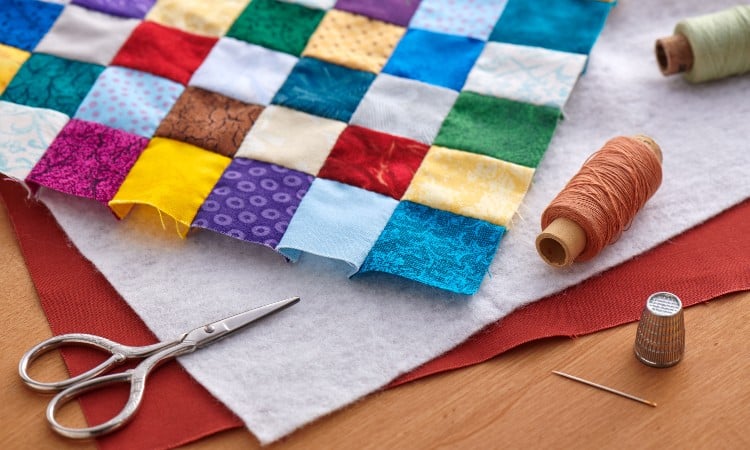
You should plan to use a piece of batting that measures 6 to 8 inches bigger than the surface of your quilt. Baby quilt batting sizes depend on the size of the quilt.
Ideally, you want to buy batting that will easily fill the entire shape of your quilt in one piece. Since baby quilts are usually quite small compared to full-sized quilts, you can often get one-piece batting easily!
So, what is batting? Batting gives you a soft, fluffy layer of insulation between the fancy piecework surface of the quilt and the plain backing of the quilt. It’s like the stuffing inside a pillow, but it comes in a flat, wide roll instead of in a big cloud-like pillow stuffing.
You can buy quilt batting in varying thicknesses, called the loft of the batting. For baby quilts, you usually do not need batting with a high loft. Instead, look for batting with a low loft. This will also sew more smoothly as you create the quilt!
You can find batting made out of many different materials. Synthetic polyester batting will cost the least, but some parents may prefer an all-natural and breathable material such as cotton.
Another thing to know about quilt batting is that you want a piece that is just a bit larger than the surface area of the quilt. This lets you easily add a pretty binding around the edge of the quilt and seal up your “quilt sandwich” with the batting in the middle!
Ultimately, you will want to measure your batting depending on the size of your baby quilt. For instance, if you have a 30” X 30” newborn quilt, you will want a piece of batting that measures at least 36” X 36”.
What Kind of Fabric Should You Use in a Baby Quilt?
The most popular fabric types to use in baby quilts include organic quilting cotton, quilting cotton, and cotton flannel. Many quilters prefer using organic cotton that has all the benefits of quilting cotton but is guaranteed to be safe against a baby’s sensitive skin because the organic fabric will not contain any chemicals or pesticides.
Why does cotton make the best baby quilts? First, you can throw cotton in your washing machine without ruining it. Babies tend to make a lot of mess, so you need to use a washable fabric!
Plus, cotton absorbs moisture easily and has excellent breathability. This means it can keep a baby warm without becoming stifling or clingy.
And, of course, cotton has a lovely soft feel to it. If you want an extra-soft cotton fabric for your quilt, you may even want to use a cotton flannel. Many fabric stores sell this kind of material in all sorts of adorable child-friendly prints and colors.
You may feel tempted by the cheaper synthetic quilting fabrics you see for sale. However, synthetic fabric like polyester may cause an allergic reaction in some infants. For this reason, it’s a good idea to choose an all-natural fabric like cotton for your handmade baby blanket.
Conclusion
Baby quilts usually come in four standard sizes for newborns or preemies, baby cribs, toddlers, and lap throws. While you can find some variation in the measurements commonly used for each of these standard types of baby quilts, using the most common measurements will help you easily plan your handmade quilt. Newborn quilts often measure 30” X 30”, crib quilts usually measure 36” X 52”, toddler quilts can measure as large as 70” X 90”, and lap throw quilts often measure 46” X 60”.
You will also need to find a piece of batting that measure about 60 to 8 inches larger than the surface of your quilt. This will provide a warm insulating layer inside the blanket.
Have you ever made a baby quilt? What size did you use, and what kind of design did it have? Leave a comment below to let us know!